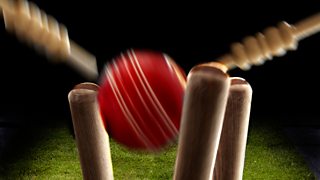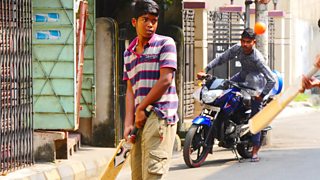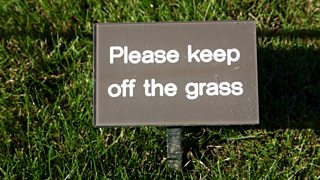Cricket, baseball, rounders and softball: What’s the difference?
In London in the summer of 2019 the New York Yankees played the Boston Red Sox in the first competitive baseball game ever to take place this side of the pond. For Radio 4’s On Baseball, Professor Michael Sandel and guests headed to a game to discuss the difference between the all-American sport and the most British of activities, cricket.
What are the distinctions between the two sports? And how do rounders and softball fit in? Check out our handy cheat sheet to get all your elongated bat and ball game related questions answered!
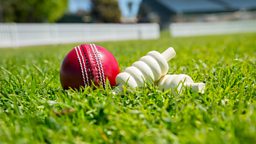
-
![]()
On Baseball
Michael Sandel talks baseball, national identity and the role of team sport in life.
CRICKET
The aim of the game
Like baseball, the object of the game is to score runs when batting and to dismiss the opposing team’s batsmen when it’s their turn. You can be bowled out (by the ball hitting the wickets), caught out or given LBW (when the ball is in line to hit the wickets but hits the batsman’s leg). A run between the wickets counts as one, a ball that rolls to the boundary makes four, and a ball that lands on the other side of the boundary makes six runs.
Number of players
There are 11 players in a team. Unlike baseball, where one batter steps up to the plate, two players will bat while the opposing team field. And whereas baseball has nine set positions, there are 36 different fielding positions in cricket, with delightful names like Silly Mid On and Short Square Leg. Like baseball, a catcher called a wicket keeper stands behind the batsman.
The Barmy Army: a niche and successful travel business
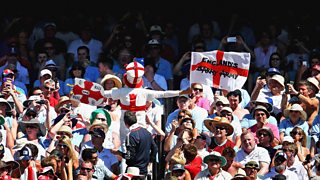
The group of friends who turned a chant at cricket matches into a movement and then a travel business.
The bat
A cricket bat is flat rather than cylindrical, and is typically made out of willow. It can be no longer than 965mm and no wider than 108mm.
There are three formats of cricket match. The test match is the traditional form of the game, taking place over five days. Then there are one-day games, and Twenty20s, where each team gets twenty overs to bowl to the opposition.
The ball
A cricket ball is hard. It has a core of cork, which is layered with tightly wound string, and covered by leather. At a maximum of 163g they’re heavier than a baseball ball, but also smaller, with a circumference of between 224mm and 229mm. A cricket ball is traditionally red, but white (and pink) balls are used in limited-over games. In cricket a ball is bowled overarm rather than thrown, and there are different types of bowlers: from fast bowlers, who use pace as their weapon, through to swing, seam and spin bowlers who try to make the ball change its course to outwit the batsman.

Batting
The force achieved by a baseball player seldom occurs in cricket. In the English game, a batsman is more often dealing with alignment, deflection and control. More power is unleashed when a batsman hits a six, and there are more of these in Twenty20 cricket (a shorter, higher tempo version of the game). A cricketer only bats once in each innings. If he’s out for a duck (first ball) he doesn’t get a chance to try again.
Duration
There are three formats of cricket match. The test match is the traditional form of the game, played since 1877, and this takes place over five days. Then there are one-day games, and Twenty20s (T20), where each team gets twenty overs to bowl to the opposing team. (There are six balls in an over.)
-
![]()
Testing the Tebbit Test
Rajan Datar examines national identity and loyalty through the lens of cricket.
-
![]()
India’s Street Cricketers: Crossing Boundaries
How street children from Kolkata got to play cricket at Lord's.
-
![]()
Build Me a Fast Bowler
Jonathan Agnew unravels the qualities that make the perfect fast bowler.
BASEBALL
The aim of the game
To score more runs than the opposing team by hitting the ball into the park and running between four bases positioned at the corners of a diamond shape pitch. The fielding team’s aim is to get the batting players out by catching the ball after it’s struck, or touching first base with the ball before they reach it. Players can run each other out too, and missing the ball when it’s pitched at you also spells bad news: three strikes and you’re out!
Number of players
There are nine players in a team. One team take turns to bat while the other fields. Of the fielding team one is a pitcher, who throws the ball to the batter, and one is a catcher, who stands behind the batter (wearing a protective mask, chest protector and shin guards).
The bat
A baseball bat is a smooth wooden or metal club no more than 7cm in diameter and no more than 42 inches in length.
In baseball, missing the ball when it's pitched (thrown) at you spells bad news: three strikes and you're out!
The ball
A baseball ball has a rubber or cork centre wrapped in yarn and then covered with two strips of white horsehide or cowhide stitched together. They can weigh between 142g and 149g and measure between 229mm and 235mm in circumference. Major league pitchers will often throw the ball at a speed of over 95 mph (no wonder the catcher needs those pads!).

Gloves
Everyone in the defending team wears a large leather glove, also known as a mitt, to help them catch and throw the ball.
Whereas baseball has nine set positions, there are 36 different fielding positions in cricket, with delightful names like Silly Mid On and Short Square Leg.
Batting
A baseball swing is explosive. The ball needs to go 100 metres for a home run (when the ball leaves the area of play) and the power needed to generate that requires an awful lot of force. The batter winds up to rotate their whole body through the ball. Each team has nine innings so every player gets to bat nine times.
Duration
A game lasts just over three hours on average but, like cricket, there’s no clock. The longest ever professional baseball game lasted eight hours and six minutes.
SOFTBALL
The bat
Although they look the same, the bats used in softball tend to be shorter, thinner and lighter than those used in baseball.
Softball was originally invented as an indoor alternative to baseball. The essentials of softball are the same as baseball, but there are some important differences.
The ball
Softball balls are larger with a circumference of 12 inches and are yellow rather than white. It won’t come as a surprise to hear that they are also much softer. The ball is pitched from a closer distance than in baseball (43 feet from the batter as opposed to 60) and the ball has to be thrown underhand. In baseball the ball is thrown overarm or sidearm for maximum speed!
The field
A softball field is smaller than in baseball: the bases are 60 rather than 90 feet apart. So there’s less running involved. This is probably because softball was originally invented as an indoor alternative to baseball.

ROUNDERS
The bat
The main difference between baseball and rounders is the batting. A rounders bat is much shorter at 18 inches (more like a truncheon) and it is usually swung one-handed. Misses or strikes are not called – the batter gets just one ball thrown to them and must run whether they hit it or not.
The game of rounders has been played in England since Tudor times, and is undoubtedly the inspiration behind baseball.
The ball
As in softball, the ball is thrown underarm. But the ball is smaller, more like a baseball ball.
The field
Unlike baseball, the bases are marked by posts (much like wickets are used in cricket). The lay-out of the pitch is also different to the American game, particularly the location of home base.
Gloves
Like cricket, fielders don’t use gloves. It seems the Brits are either hardier or foolhardy!
Listen to On Baseball, as Professor Michael Sandel and guests headed to a game to discuss the difference between the all-American sport and the most British of activities, cricket.
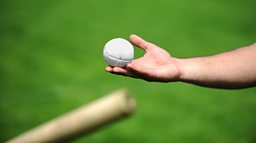
-
![]()
On Baseball
Michael Sandel talks baseball, national identity and the role of team sport in life.
-
![]()
The eight secrets of fast bowling
Facts from the frontier of cricketing science.
-
![]()
Why the sales of fake grass are growing
Simon Hoban finds out why consumers are falling in love with a green and plastic lawn.
-
![]()
What was the Hollywood Cricket Club?
There was only one place if you were an aspiring British actor in the heyday of Hollywood.

